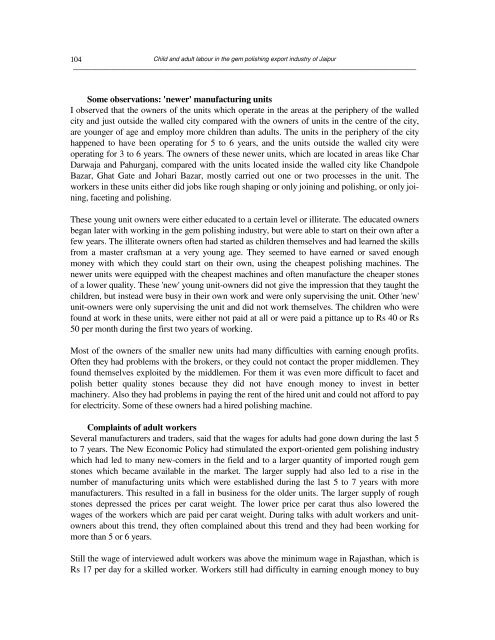Create successful ePaper yourself
Turn your PDF publications into a flip-book with our unique Google optimized e-Paper software.
104<br />
<strong>Child</strong> <strong>and</strong> <strong>adult</strong> <strong>labour</strong> <strong>in</strong> <strong>the</strong> <strong>gem</strong> polish<strong>in</strong>g <strong>export</strong> <strong>in</strong>dustry <strong>of</strong> Jaipur<br />
──────────────────────────────────────────────────────────────────────────────────────────────<br />
Some observations: 'newer' manufactur<strong>in</strong>g units<br />
I observed that <strong>the</strong> owners <strong>of</strong> <strong>the</strong> units which operate <strong>in</strong> <strong>the</strong> areas at <strong>the</strong> periphery <strong>of</strong> <strong>the</strong> walled<br />
city <strong>and</strong> just outside <strong>the</strong> walled city compared with <strong>the</strong> owners <strong>of</strong> units <strong>in</strong> <strong>the</strong> centre <strong>of</strong> <strong>the</strong> city,<br />
are younger <strong>of</strong> age <strong>and</strong> employ more children than <strong>adult</strong>s. The units <strong>in</strong> <strong>the</strong> periphery <strong>of</strong> <strong>the</strong> city<br />
happened to have been operat<strong>in</strong>g for 5 to 6 years, <strong>and</strong> <strong>the</strong> units outside <strong>the</strong> walled city were<br />
operat<strong>in</strong>g for 3 to 6 years. The owners <strong>of</strong> <strong>the</strong>se newer units, which are located <strong>in</strong> areas like Char<br />
Darwaja <strong>and</strong> Pahurganj, compared with <strong>the</strong> units located <strong>in</strong>side <strong>the</strong> walled city like Ch<strong>and</strong>pole<br />
Bazar, Ghat Gate <strong>and</strong> Johari Bazar, mostly carried out one or two processes <strong>in</strong> <strong>the</strong> unit. The<br />
workers <strong>in</strong> <strong>the</strong>se units ei<strong>the</strong>r did jobs like rough shap<strong>in</strong>g or only jo<strong>in</strong><strong>in</strong>g <strong>and</strong> polish<strong>in</strong>g, or only jo<strong>in</strong><strong>in</strong>g,<br />
facet<strong>in</strong>g <strong>and</strong> polish<strong>in</strong>g.<br />
These young unit owners were ei<strong>the</strong>r educated to a certa<strong>in</strong> level or illiterate. The educated owners<br />
began later with work<strong>in</strong>g <strong>in</strong> <strong>the</strong> <strong>gem</strong> polish<strong>in</strong>g <strong>in</strong>dustry, but were able to start on <strong>the</strong>ir own after a<br />
few years. The illiterate owners <strong>of</strong>ten had started as children <strong>the</strong>mselves <strong>and</strong> had learned <strong>the</strong> skills<br />
from a master craftsman at a very young age. They seemed to have earned or saved enough<br />
money with which <strong>the</strong>y could start on <strong>the</strong>ir own, us<strong>in</strong>g <strong>the</strong> cheapest polish<strong>in</strong>g mach<strong>in</strong>es. The<br />
newer units were equipped with <strong>the</strong> cheapest mach<strong>in</strong>es <strong>and</strong> <strong>of</strong>ten manufacture <strong>the</strong> cheaper stones<br />
<strong>of</strong> a lower quality. These 'new' young unit-owners did not give <strong>the</strong> impression that <strong>the</strong>y taught <strong>the</strong><br />
children, but <strong>in</strong>stead were busy <strong>in</strong> <strong>the</strong>ir own work <strong>and</strong> were only supervis<strong>in</strong>g <strong>the</strong> unit. O<strong>the</strong>r 'new'<br />
unit-owners were only supervis<strong>in</strong>g <strong>the</strong> unit <strong>and</strong> did not work <strong>the</strong>mselves. The children who were<br />
found at work <strong>in</strong> <strong>the</strong>se units, were ei<strong>the</strong>r not paid at all or were paid a pittance up to Rs 40 or Rs<br />
50 per month dur<strong>in</strong>g <strong>the</strong> first two years <strong>of</strong> work<strong>in</strong>g.<br />
Most <strong>of</strong> <strong>the</strong> owners <strong>of</strong> <strong>the</strong> smaller new units had many difficulties with earn<strong>in</strong>g enough pr<strong>of</strong>its.<br />
Often <strong>the</strong>y had problems with <strong>the</strong> brokers, or <strong>the</strong>y could not contact <strong>the</strong> proper middlemen. They<br />
found <strong>the</strong>mselves exploited by <strong>the</strong> middlemen. For <strong>the</strong>m it was even more difficult to facet <strong>and</strong><br />
polish better quality stones because <strong>the</strong>y did not have enough money to <strong>in</strong>vest <strong>in</strong> better<br />
mach<strong>in</strong>ery. Also <strong>the</strong>y had problems <strong>in</strong> pay<strong>in</strong>g <strong>the</strong> rent <strong>of</strong> <strong>the</strong> hired unit <strong>and</strong> could not afford to pay<br />
for electricity. Some <strong>of</strong> <strong>the</strong>se owners had a hired polish<strong>in</strong>g mach<strong>in</strong>e.<br />
Compla<strong>in</strong>ts <strong>of</strong> <strong>adult</strong> workers<br />
Several manufacturers <strong>and</strong> traders, said that <strong>the</strong> wages for <strong>adult</strong>s had gone down dur<strong>in</strong>g <strong>the</strong> last 5<br />
to 7 years. The New Economic Policy had stimulated <strong>the</strong> <strong>export</strong>-<strong>oriented</strong> <strong>gem</strong> polish<strong>in</strong>g <strong>in</strong>dustry<br />
which had led to many new-comers <strong>in</strong> <strong>the</strong> field <strong>and</strong> to a larger quantity <strong>of</strong> imported rough <strong>gem</strong><br />
stones which became available <strong>in</strong> <strong>the</strong> market. The larger supply had also led to a rise <strong>in</strong> <strong>the</strong><br />
number <strong>of</strong> manufactur<strong>in</strong>g units which were established dur<strong>in</strong>g <strong>the</strong> last 5 to 7 years with more<br />
manufacturers. This resulted <strong>in</strong> a fall <strong>in</strong> bus<strong>in</strong>ess for <strong>the</strong> older units. The larger supply <strong>of</strong> rough<br />
stones depressed <strong>the</strong> prices per carat weight. The lower price per carat thus also lowered <strong>the</strong><br />
wages <strong>of</strong> <strong>the</strong> workers which are paid per carat weight. Dur<strong>in</strong>g talks with <strong>adult</strong> workers <strong>and</strong> unitowners<br />
about this trend, <strong>the</strong>y <strong>of</strong>ten compla<strong>in</strong>ed about this trend <strong>and</strong> <strong>the</strong>y had been work<strong>in</strong>g for<br />
more than 5 or 6 years.<br />
Still <strong>the</strong> wage <strong>of</strong> <strong>in</strong>terviewed <strong>adult</strong> workers was above <strong>the</strong> m<strong>in</strong>imum wage <strong>in</strong> Rajasthan, which is<br />
Rs 17 per day for a skilled worker. Workers still had difficulty <strong>in</strong> earn<strong>in</strong>g enough money to buy


















